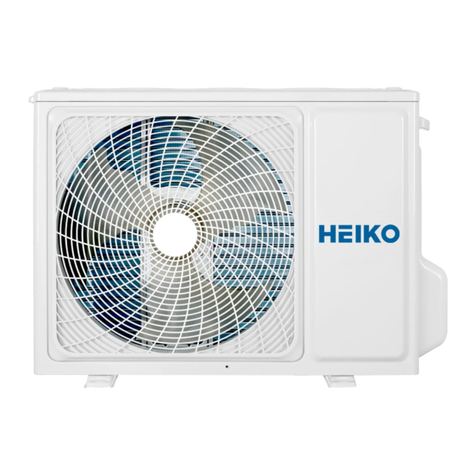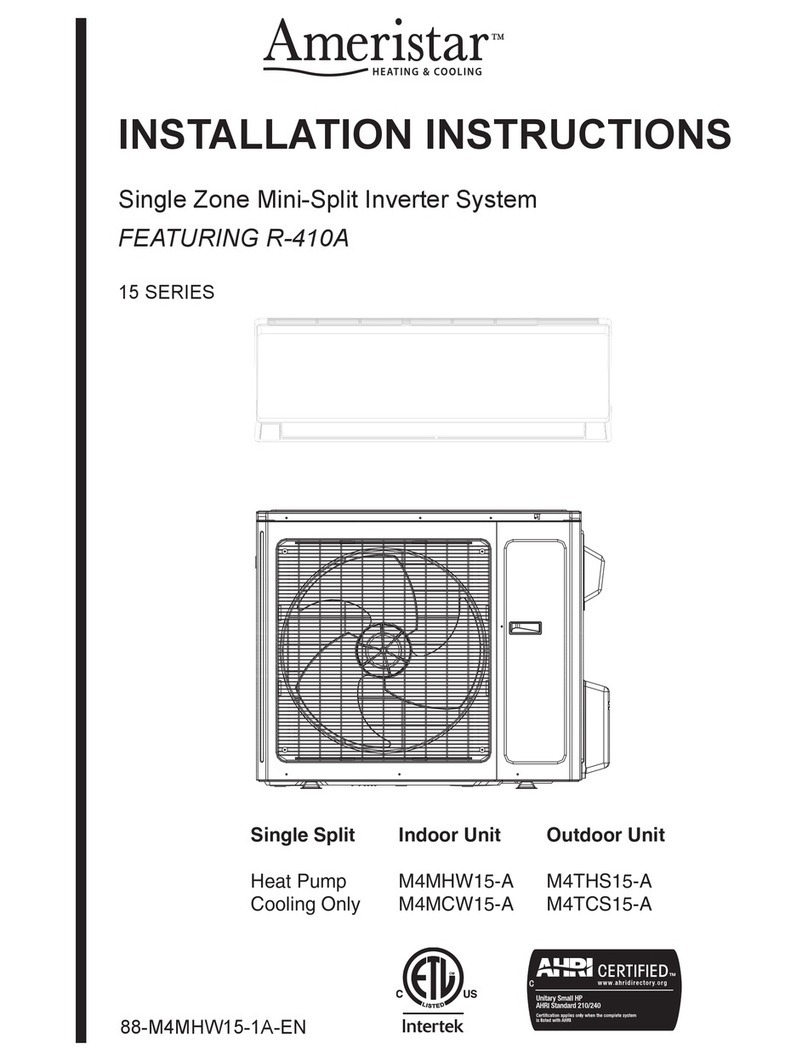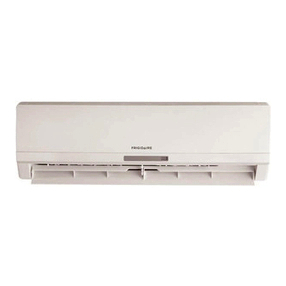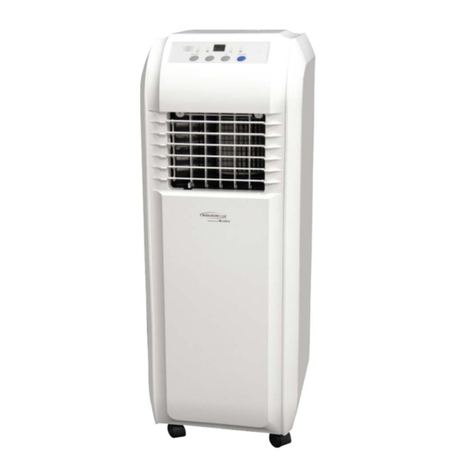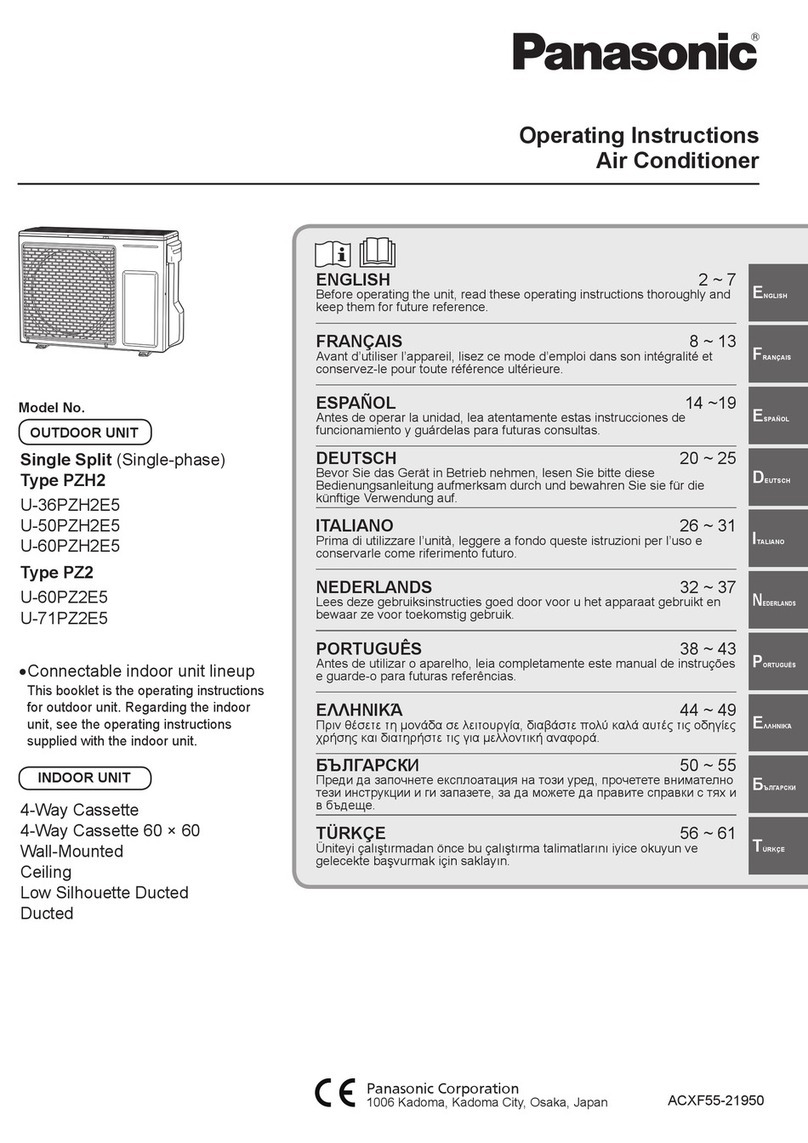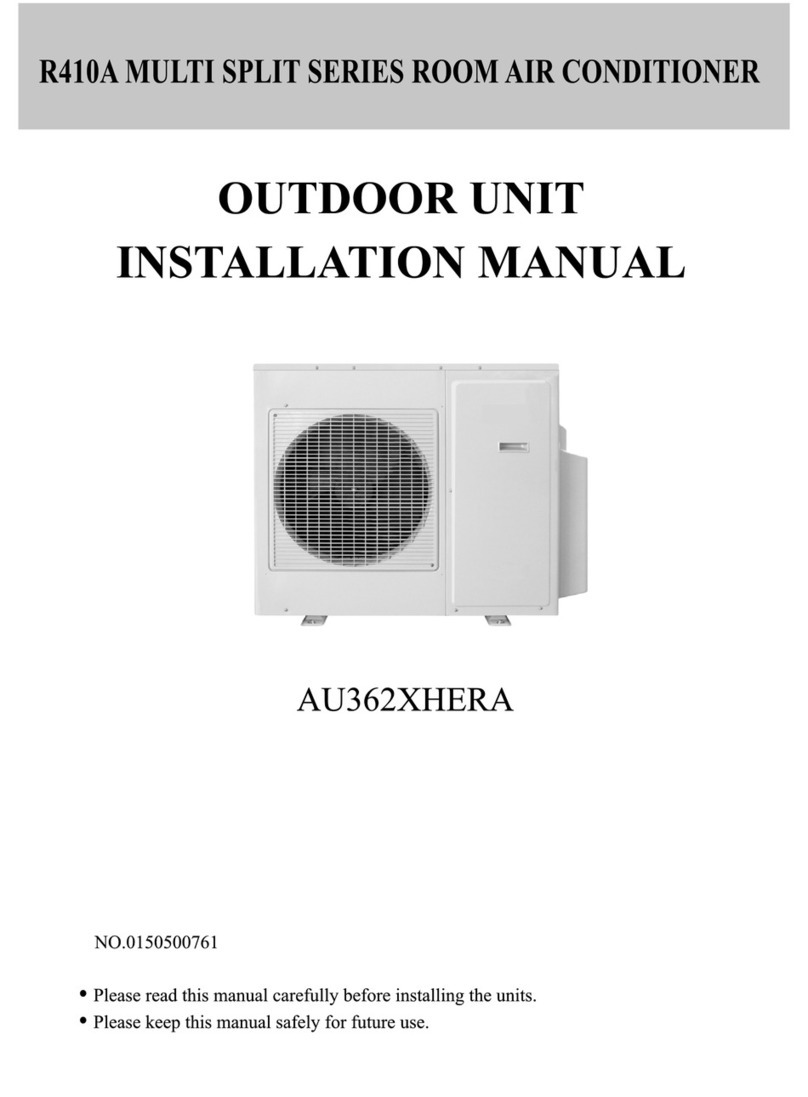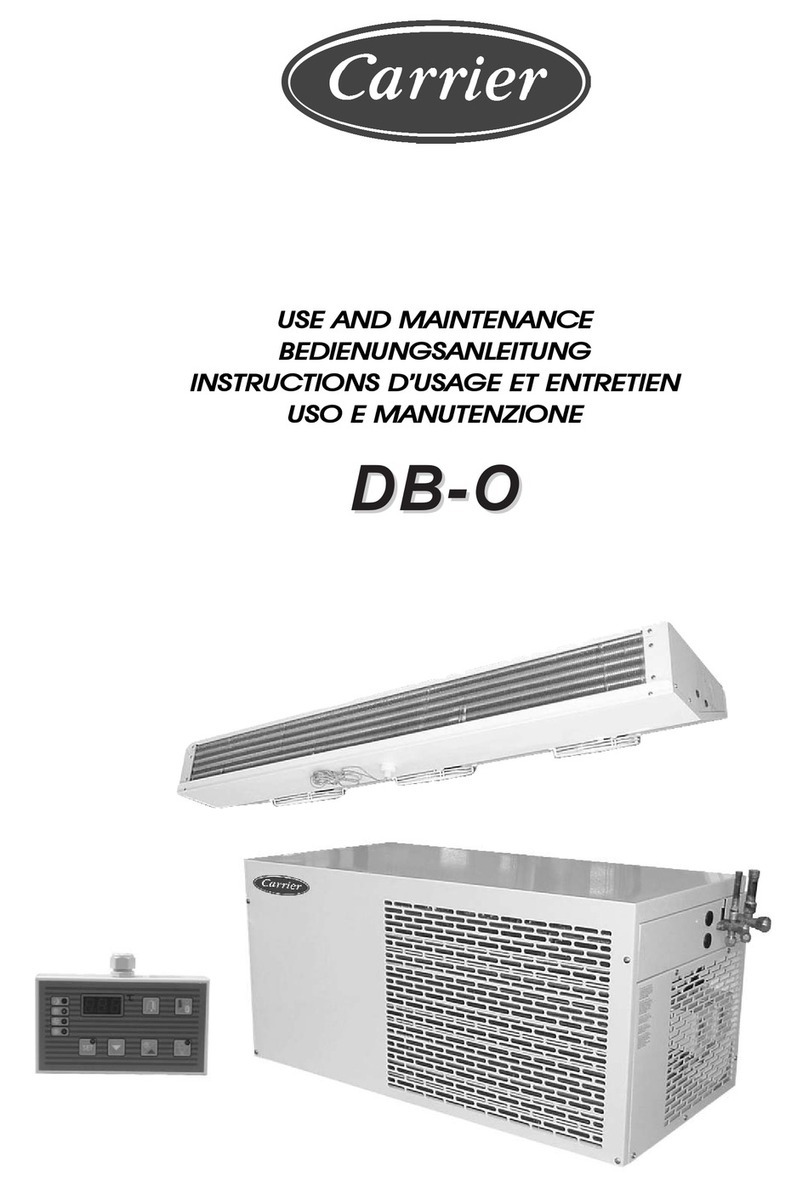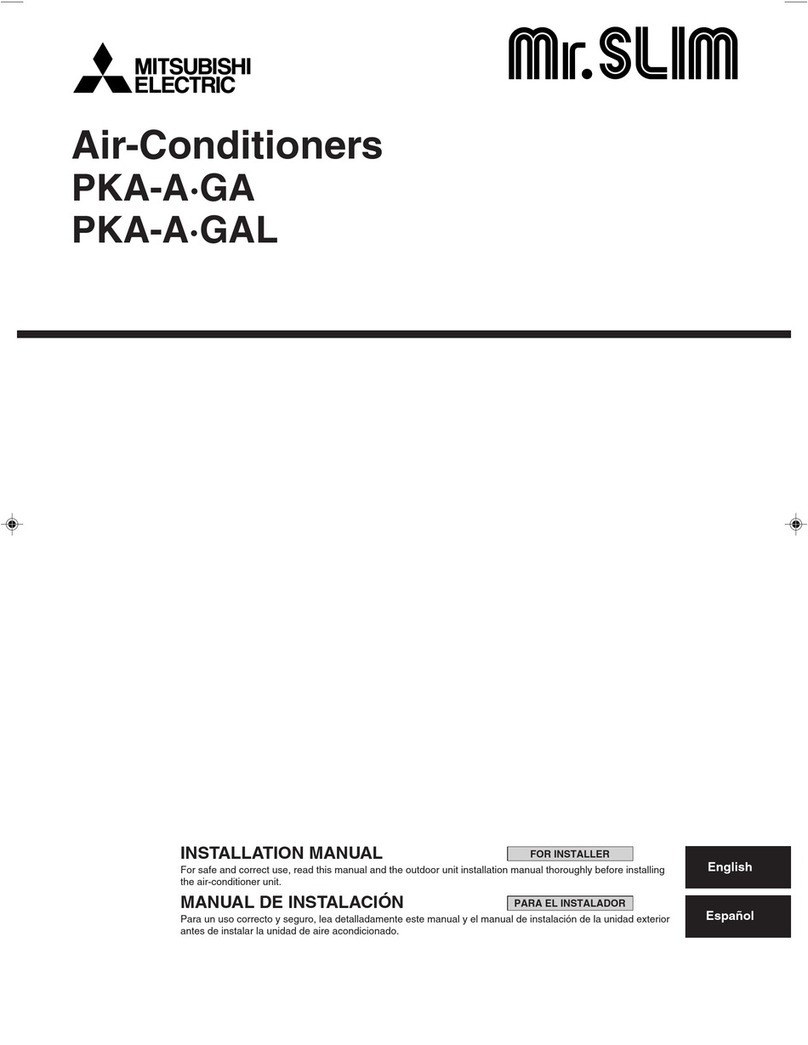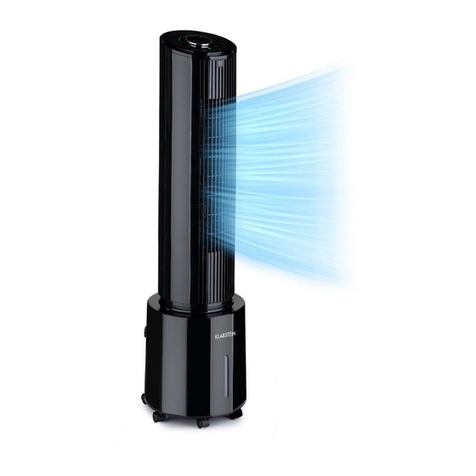Heiko JZ050-C2 User manual

SERVICE MANUAL
This service information is designed for experienced repair technicians only and is not designed for use by the general publi
●c.
It does not contain warnings or cautions to advise non-technical individuals of potential dangers in attempting to service a product.
Products powered by electricity should be serviced or repaired only by experienced professional technicians. Any attempt to service or
Repair the product or products dealt with in this service information by anyone else could result in serious injury or death
WARNING
Model JZ050-C2
Version V1 Date 20201204

Contents
Domestic air conditioner
Contents
1.Introduction .............................................................................................1
2.Specifications..........................................................................................7
3.Sensors list
●.............................................................................................8
4.Pinping diagrams
●....................................................................................9
5.Operation range....................................................................................10
6.Printed Circuit Board Connector Wiring Diagram ................................. 11
7.Outdoor Functions and Control.............................................................
14
8.Dimensional drawings
●...........................................................................28
10.Service Diagnosis
●...............................................................................29
11.Performence and cerves diagrams .....................................................45
12.Sound level .........................................................................................61
13.Circuit diagrams..................................................................................62

Introduction
1Domestic air conditioner
1.Introduction
1.1 Model name explanation
J Z 5 - C2
Nominal cooling capacity(18000BTU/h)
Outdoor unit
series
00

Introduction
2 Domestic air conditioner
1.2 Safety Cautions
Be sure to read the following safety cautions before conducting repair work.
The caution items are classified into “Warning” and “Caution”. The “Warning” items are especially important
since they can lead to death or serious injury if they are not followed closely. The “Caution” items can also lead
●
to serious accidents under some conditions if they are not followed. Therefore, be sure to observe all the safety
caution items described below.
About the pictograms
△This symbol indicates an item for which caution must be exercised.
The pictogram shows the item to which attention must be paid.
○ This symbol indicates a prohibited action.
The prohibited item or action is shown inside or near the symbol.
● This symbol indicates an action that must be taken, or an instruction.
The instruction is shown inside or near the symbol.
After the repair work is complete, be sure to conduct a test operation to ensure that the equipment operates
Normally, and explain the cautions for operating the product to the customer.
1.2.1 Embedded wire checking before installation
Check the embedded wire diameter suitable to request:
(Power supply from indoor: 2.5kw ≥1.0mm2 3.5kw,5kw ≥1.5mm2 7kw ≥1.0mm2 ; Power supply from outdoor
≥1.0mm2 )
Check the embedded wire are four roots, L/N/COM/GND; GND is needed, if
●not, thunder or high voltage wave
from power grid will impact to the performance
●
Using a multi-meter to test short circuit of the four roots wires, make sure no short circuit happen.
●
1.2.2 Caution in Repair
●
Warning
Be sure to disconnect the power cable plug from the plug socket before disassembling the equipment for
a repair.
Working on the equipment that is connected to a power supply can cause an electrical shook.
If it is necessary to supply power to the equipment to conduct the repair or inspecting the circuits, do not
touch any electrically charged sections of the equipment.
If the refrigerant gas discharges during the repair work, do not touch the discharging refrigerant gas .The
refrigerant gas can cause frostbite.

Introduction
3 Domestic air conditioner
When disconnecting the suction or discharge pipe of the compressor at the welded section, release the
refrigerant gas completely at a well-ventilated place first.
If there is a gas remaining inside the compressor , the refrigerant gas or refrigerating machine oil
discharges when the pipe is disconnected, and it can cause injury.
If the refrigerant gas leaks during the repair work, ventilate the area. The refrigerant gas can generate
●
toxic gases when it contacts flames.
The step-up capacitor supplies high-voltage electricity to the electrical components of the outdoor unit.
Be sure to discharge the capacitor completely before conducting repair work . A charged capacitor can
cause an electrical shock.
Do not start or stop the air conditioner operation by plugging or unplugging the power cable plug.
Plugging or unplugging the power cable plug to operate the equipment can cause an electrical shock or
fire.
Warning
Do not repair the electrical components with wet hands .
● Working on the equipment with wet hands can
cause an electrical shock
●
Do not clean the air conditioner by splashing water. Washing the unit with water can cause an electrical
●
shock.
Be sure to provide the grounding when repairing the equipment in a humid or wet place, to avoid
electrical
shock.
Be sure to turn off the power switch and unplug the power cable when cleaning the equipment. The
internal fan rotates at a high speed, and cause injury.
Do not tilt the unit when removing it. The water
●inside the unit can spill and wet the furniture and floor.
Be sure to check that the refrigerating cycle section has cooled down sufficiently before conducting
repair
work. Working on the unit when the refrigerating cycle section is hot can cause burns.
Use the welder in a well-ventilated place. Using the welder in an enclosed room can cause oxygen
deficiency.
1.2.3 Cautions Regarding Products after Repair
Warning
Be sure to use parts listed in the service parts list of the applicable model and appropriate tools to

Introduction
4 Domestic air conditioner
conduct repair work. Never attempt to modify the equipment. The use of inappropriate parts or tools can
cause an electrical shock, excessive heat generation or fire.
When relocating the equipment, make sure that the new installation site has sufficient strength to
withstand the weight of the equipment.
If the installation site does not have sufficient strength and if the installation work is not conducted
securely, the equipment can fall and cause injury.
Be sure to install the product correctly by using the provided standard installation frame.
Incorrect use of the installation frame and improper installation can cause the equipment to fall, resulting
in injury.
For
integral
units only
Be sure to install the product securely in the installation frame mounted on a window frame.
If the unit is not securely mounted, it can fall and cause injury.
For
integral
units only
Warning
Be sure to use an exclusive power circuit for the equipment, and follow the technical standards related to
●
the electrical equipment, the internal wiring regulations and the instruction manual for installation when
●
conducting electrical work.
●
Insufficient power circuit capacity and improper electrical work can cause an electrical shock or fire.
Be sure to use the specified cable to connect between the indoor and outdoor units. Make the
connections securely and route the cable properly so that there is no force pulling the cable at the
connection terminals.
Improper connections can cause excessive heat generation or fire.
When connecting the cable between the indoor and outdoor units, make sure that the terminal cover
does
not lift off or dismount because of the cable.
●
If the cover is not mounted properly, the terminal connection section can cause an electrical shock,
excessive heat generation or fire.
Do not damage or modify the power cable.
Damaged or modified power cable can cause an electrical shock or fire. Placing heavy items on the
power cable, and heating or pulling the power cable can damage the cable.
●
Do not mix air or gas other than the specified refrigerant (R32) in the refrigerant system.
If air enters the refrigerating system, an excessively high pressure results, causing equipment damage
and injury.
If the refrigerant gas leaks, be sure to locate the leak and repair it before charging the refrigerant. After
charging refrigerant, make sure that there is no refrigerant leak.
If the leak cannot be located and the repair work must be stopped, be sure to perform pump-down and
close the service valve, to prevent the refrigerant gas from leaking into the room. The refrigerant gas
.

Introduction
5 Domestic air conditioner
itself
is harmless, but it can generate toxic gases when it contacts flames, such as fan and other heaters,
stoves and ranges.
When replacing the coin battery in the remote controller, be sure to disposed of the old battery to prevent
children from swallowing it.
If a child swallows the coin battery, see a doctor immediately.
Caution
Installation of a leakage breaker is necessary in some cases depending on the conditions of the
●
installation site, to prevent electrical shocks.
Do not install the equipment
● in a place where there is a possibility of combustible gas leaks.
If a combustible gas leaks and remains around the unit, it can cause a fire.
Be sure to install the packing and seal on the installation frame properly. If the packing and seal are not
installed properly, water can enter the room and wet the furniture and floor.
1.2.4 Inspection after Repair
●
Warning
Check to make sure that the power cable plug is not dirty or loose, then insert the plug into a power outlet
all the way.
If the plug has dust or loose connection, it can cause an electrical shock or fire.
If the power cable and lead wires have scratches or deteriorated, be sure to replace them.
●
Damaged cable and wires can cause an electrical shock, excessive heat generation or fire.
Warning
●
Do not use a joined power cable or extension cable, or share the same power outlet with other electrical
appliances since it can cause an electrical shock, excessive heat generation or fire.

Introduction
6 Domestic air conditioner
Caution
Check to see if the parts and wires are mounted and connected properly, and if the connections at the
soldered or crimped terminals are secure. Improper installation and connections can cause excessive
heat generation, fire or an electrical shock.
●
If the installation platform or frame has corroded, replace it. Corroded installation platform or frame can
cause the unit to fall, resulting in injury.
●
Check the grounding, and repair it if the equipment is not properly grounded. Improper grounding can
cause an electrical shock.
Be sure to measure the insulation resistance after the repair, and make sure that the resistance is 1 M
ohm or higher.
Faulty insulation can cause an electrical shock.
Be sure to check the drainage of the indoor unit after the repair.
●
Faulty drainage can cause the water to enter the room and wet the furniture and floor.
1.2.4 Using Icons
Icons are used to attract the attention of the reader to specific information. The meaning of each icon is described in
the table below:
1.2.5 Using Icons List
Icon Type of Information
● Description
Note Note A “note” provides information that is not indispensable, but may
nevertheless be valuable to the reader, such as tips and tricks.
Caution
● Caution
A “caution” is used when there is danger that the reader, through
incorrect manipulation, may damage equipment, loose data, get
an
unexpected result or has to restart (part of) a procedure.
Warning Warning A “warning” is used when there is danger of personal injury.
Reference
A “reference” guides the reader to other places in this binder or in
this manual, where he/she will find additional information on a
specific topic.

Specification
7Domestic air conditioner
2.Specifications
NOMINAL DISTRIBUTION SYSTEM VOLTAGE
●
1/esah
P
05zHyc
neuqerF
220-240
Vegatlo
V
NOMINAL CAPACITY and NOMINAL INPUT
gnitaeh
gnilooC
Capacity rated kW 5 5.2
Btu/h
●17060 17740
Power Consumption(Rated)kW 1.55 1.40
+A/0.4++
A/6.1W/WPOCS/REES
Annual energy consumption kWh 287 1610
h/³mla
vomeRerutsioM 2.0*10﹣³
TECHNICAL SPECIFICATIONS-UNIT
Dimensions H*W*D
●mm 800×275×553
Packaged
Dimensions H*W*D mm 954x409x625
Weight / KG
●32.7
Gross weight / KG 36.5
Sound level Sound peessure dB 53
Sound power dB 65
ELECTRICAL SPECIFICATIONS
gnitaeh
gnilooC
Nominal running current A 7.0 6.3
Maximum running current A 8.9 11.3
11Atne
rrucgnitratS
TECHNICAL SPECIFICATIONS-PARTS
gnitaeh
gnilooc
Compressor
r
osserpmoCyratoRepyT
GTD130RKRF8LV6B
ledoM
Motor output
●W 1069
ACS-68R or equivalent
epytli
O
Oil charge volume L 0.44
Fan
nafl
aixAepyT
Motor output W 40
Air flow rate(high) m³/h 2500
Speed(high/low) rpm 950/300
-nifLMepy
TtaeH φ7HI-HX tube

Specification
8Domestic air conditioner
4.1*
62*2hctif*egats*woRregnahcxe
TECHNICAL SPECIFICATIONS-OTHERS
Refrigerant
circuit
Refrigerant type R32
Refrigerant charge KG 0.90
Maximum allowable distance
between indoor an outdoor M 25
Maximum allowable level difference
●m 15
Refrigerant control
Piping connections
(external diameter)
liquid mm Φ6.35
gas mm Φ12.7
drain
●mm Φ16
Heat insulation type Both liquid and Gas pipes
●
Max. piping Length m
●25
Max. Level Difference m 15
Chargeless m 7
Amount of Additional Charge of Refrigerant g/m 20
Note: the data are based on the conditions shown in the table below
htgne
lgnipiPgnitaehgnilooc
Indoor: 27 DB/19 WB℃ ℃
Outdoor: 35 DB/24 WB℃ ℃
Indoor:20 DB℃
Outdoor: 7 DB/6 WB℃ ℃ 5m
3.Sensors list
type Description Qty
Ambient sensor Its used for detecting temperature of outdoor side
1
Defrosting sensor Its used for controlling outdoor defrosting at heating mode
Descharging sensor Its used for compressor in case of over-heat
Conversation formulae
Kcal/h= kW×860
Btu/h= kW×3414
cfm=m³/min×35.3
capillary

Piping diagrams
9Domestic air conditioner
4.Piping diagrams

Operation range
10 Domestic air conditioner
5.Operation range
-10
0
21
27
35
20
40
60
43
-20
-40

Wiringdiagrams
11 Domestic air conditioner
6.Printed Circuit Board Connector Wiring Diagram
Connectors
PCB (1) (Outdoor Control PCB)
1 CN1 Connector for power N and
●L
2 CN2
3 CN3 Connector for ground
4 CN2’
Connector for the U, V, W wire of the compressor5 CN3’
6 CN4’
7 LI (CN7)
Connector for reactor
8 LO (CN6)
9 CN21 Connector for fan motor
10 CN10 Connector for four way valve coil
11 CN20 Connector for Temperature sensor
12 CN18
13 CN5 Connector for Terminal Socket-protection
14 CN4 Connector for communicate between indoor and outdoor unit
15 CN16 Connector for electric expansion valves
Note: Other Designations
●
1) FUSE 1, (20A, 250VAC); FUSE 2(3.15A, 250VAC)
2) LED 1 Keep light representative normal, if keep flash interval representative trouble Alarm
3) RV1, RV2, RV3, RV4 Varistor

Wiringdiagrams
12 Domestic air conditioner
PCB (1)
Bottom
heater
4-way valve
E-valve
Sensor
●
DC fan motor
●
PFC Reactor
Compressor
L N PE
S

Wiring diagrams
Wiring diagrams
13 Domestic air conditioner

Functions and control
14 Domestic air conditioner
7.Outdoor Functions and Control
7.1 Main functions and control specification
7
●.1.1 The operation frequency of outdoor unit and its control
7.1.1.1 The operation frequency control of compressor
The operation frequency scope of compressor:
Mode Minimu
●m operation frequency Maximum operation frequency
Heating 20Hz 85Hz
Refrigeration 20Hz 112Hz
7.1.1.2 The starting of compressor
When the compressor is started for the first time, it must be kept under the conditions of
38Hz,58Hz,88Hz for 30second,one minute, one minute (the overheating protection of the outdoor unit
air-blowing temperature, immediately decrease the frequency when the compressor is overflowing and
releasing the pressure),then it can be operated towards the target frequency. When the machine runs
normally, there’s no such process. After starting the compressor for operation, the compressor should
run according to the calculated frequency, and every determined frequency for protection should be
●
prior to the calculated frequency.
7.1.1.3 The speeds of increasing or decreasing the frequency of the compressor
The speed of increasing or decreasing the frequency rapidly 1 -----------1HZ/second
The speed of increasing or decreasing the frequency slowly 2 -----------1HZ/10seconds
7.1.1.4 The calculation of the compressor’s frequency
Refrigeration/dehumidification mode:
Pn=(Nh_c- S_c)*10≥50 outdoor environment control
Pn=(Nh_c- S_c) *10<50 PID control
Heating mode:
Pn=(S_c -Nh_c) *10≥60 outdoor environment control
Pn=(S_c -Nh_c) *10<60 PID control
(Nh_c=indoor
●environment temperature S_c=setting temperature)
1)The minimum/maximum frequency limitation
A.While refrigerating: F-MAX-r is the maximum operation frequency of the compressor; F-MIN-r is the
minimum operation frequency of the compressor.
B.While heating: F-MAX-d is the maximum operation frequency of the compressor; F-MIN-d is the
minimum operation frequency of the compressor.
2)The frequency limitation which is affected by the environment temperature.
(Wh_c= environment temperature)
Heating mode:
Serial No. Temperature scope Frequency limitation
1 Wh_c<-12 Max_hz1 112HZ

Functions and control
15 Domestic air conditioner
2 Wh_c<-8 Max_hz2 112HZ
3 Wh_c<-2 Max_hz3 112HZ
4 Wh_c<5 Max_hz4 94HZ
5 Wh_c<10 Max_hz5 78HZ
6 Wh_c<17 Max_hz6 67HZ
7 Wh_c<20 Max_hz7 56HZ
8 Wh_c>=20 Max_hz8 52HZ
Remarks: The above are the maximum frequency limitations of the complete appliance which are
affected by the environment, and they have nothing to do with the ability of the indoor unit.
Refrigeration/dehumidification mode:
Serial No. Temperature scope Frequency limitation
1 Wh_c<16 Max_hz1 37HZ
2 Wh_c<22 Max_hz2 48HZ
3 Wh_c<29 Max_hz3 61HZ
4 Wh_c<32 Max_hz4 70HZ
5 Wh_c<40 Max_hz5 84HZ
6 Wh_c<48 Max_hz6 65HZ
7 Wh_c>=48 Max_hz7 54HZ
Remarks: the above are not only the maximum frequency limitations of the complete appliance
which are affected by the environment, but also the maximum ability limitation of the system. When the
starting ability is not the maximum, its maximum frequency limitation is calculated by the following
●
equations:
The frequency limitation which is affected by the temperature and under the condition of actual
ability=the actual running system ability*the maximum frequency which is limited by the temperature
and under the condition of maximum ability/the maximum designing ability of the system
Refrigeration/dehumidification mode:
Heating mode:
●
The calculation of the actual output frequency:
●
F= F-ED-*(rated frequency)×K
F
●-ED-*(rated frequency)= The frequency which is limited by the outdoor environment temperature
Notes:
The indoor setting
airflow speed Low Medium Quiet
The percentage of the
rated frequency K 70% 85% 50%
The indoor setting
airflow speed Low Medium Quiet
The percentage of the
rated frequency K 73% 90% 51%

Functions and control
When refrigerating, it is needed to satisfy
F-MIN-d(compressor’s Min_hz)< F<F-MAX-d(compressor’s Max_hz)
When heating, it is needed to satisfy
F-MIN-r (compressor’s Min_hz)< F<F-MAX-r (compressor’s Max_hz)
PID control :
The innital frequency Sn is determined by Pn . We can calculate Hzoutf according to the value of
Kp ,Ki ,Kd, Out_gain,Pn.Then , Fn = Sn + Hzoutf. The value of Fn is calculated in each sample time (60
seconds),and Fn is adujusted
●according toprevious frequency of Sn and filtered output of Hzoutf.
7.1.2 The outdoor fan control (Exchange fan)
When the fan is
●changed among every airflow speed (including stop blowing), in order to avoid the
airflow speed from skipping frequently, it must be kept under each mode for over 30 seconds, and then
●
it can be changed to another mode (when refrigerating, the time is changed to 15 seconds).
7.1.2.1 The outdoor DC fan control
Within three minutes of compressor starting, the compressor is controled according to the ambient
temperature.
Tao(℃) Tao <22℃22℃< Tao <29℃Tao≥29℃
Refrigeration/dehumidification 500rpm 600rpm 700rpm
Tao(℃) Tao <<10℃10℃< Tao <16℃Tao≥16℃
Heating 800rpm 760rpm 400rpm
After 3 minutes, the compressor is controled according to the ambient temperature and the frequency
of the compressor.
Refrigeration/dehumidification <51 Hz 51-70 Hz ≥70 Hz
frequency(Hz)
≤22 500rpm 600rpm 700rpm
2222-29 500rpm 600rpm 760rpm
Tao(℃) 29-38 600rpm 700rpm 800rpm
≥38 800rpm
Heating frequency(Hz)<51 Hz 51-90 Hz ≥90 Hz
≤10 760rpm 850rpm 950rpm
Tao(℃) 10
●-17 400rpm 760rpm 800rpm
≥17 400rpm
16 Domestic air conditioner

Functions and control
17 Domestic air conditioner
7.1.4 Four way control
For the details of defrosting four-way valve control, see the defrosting process.
Four way working in other ways:
Under the mode of heating, open the four-way valve, when the compressor is not started or changed to
non-heating mode, make sure the compressor is stoped for 2 minutes, and then close the four-way valve.
7.1.5 Protection function
7.1.5.1 TTC high temperature-preventing protection
Once the machine is started, it can run TTC(air-blowing temp) overheating protection of air-blowing,
but air-blowing sensor malfunction must alarm after 4 minutes during which the compressor is started
(during the course of self-detection, there’s no such limitation)
Sensor detection methods: 100 times (one cycle of procedure run is one time, and about 5ms,
detection method for eac
●h time: continuously sampling for 8 times, then order them and take the mean
value of the middle
●2 values), take the mean value.
TTC(℃)
●Abnormal stop
108 Decreasing the frequency rapidly(1HZ/second)
104
Decreasing the frequency slowly (1HZ/10seconds)
102The frequency doesn’t change.
100
Increasing the frequency (1HZ/10second)
93 Increasing the frequency(1HZ/1second)
TTC>=110℃
●lasts for 20 seconds. Overheating protection of air-blowing, alarm malfunction to the
indoor, others don’t last.
●
7.1.5.2 TC high temperature-preventing control of the indoor heating unit:
Tpg_indoor is the highest value of the effective indoor unit (start it and it is in accord with the running

Functions and control
18 Domestic air conditioner
state). TC=indoor coil temp.
The indoor heat exchanger sensor tests the temperature of the indoor heat exchanger. If the
temperature is higher than 63℃, decrease the rotate speed of the compressor and do the high
temperature-preventing protection of the indoor heat exchanger; if the temperature of the indoor heat
exchanger is lower than 4
●5℃, recover to the normal control.
(09K12K)
TC(℃) The compressor stops Fgh_t1 63℃/63℃
Fgh_t1-2
Fgh_t2-2 N Decreasing the frequency rapidly Fgh_t2 60℃/59℃
P Decreasing the frequency slowly Fgh_t3 57℃/56℃
Fgh_t3-2
Fgh_t4—2 Q Prohibiting increasing the frequency Fgh_t4 52℃/53℃
R Increasing slowly Fgh_t5 40℃/40 ℃
Fgh_t5—2
Normal
N:Decreasing at the speed of 1HZ/1 second
●
P:Decreasing at the speed of 1Hz/10 seconds
●
Q:Continue to keep the last-time instruction cycle
R:Increasing at the speed of 1Hz/10seconds
Remarks: the outdoor unit
7.1.5.3 The control of preventing the over current of the compressor:
●During the starting process of the compressor, if the current of the compressor is greater than 12.5A
for 3 seconds, stop the compressor and alarm, after 3 minutes, start it again, if such state appears 3 times
in 20 minutes, stop the compressor and alarm, and confirm the malfunction. Then continue to run it only
after the power is off.
●During the starting process of the compressor, if the AC current is greater than 9A, the frequency of
the compressor decreases at the speed of 1HZ/second.
●During the starting process of the compressor, if the AC current is greater than 8A, the frequency of
the compressor decreases at the speed of 0.1HZ/second.
●During the starting process of the compressor, if the AC current is greater than 7.5A, the frequency of
the compressor increases at the prohibited speed.
●During the starting process of the compressor, if the AC current is greater than 6.5A, the frequency of
the compressor increases at the speed of no faster than 0.1HZ/second.
7.1.5.4 The protection function of AC current:
During the starting process of the compressor, if the AC current is greater than 12.5A for 3 seconds,
stop the compressor and alarm, after 3 minutes, start it again, if such state appears 3 times in 20 minutes,
●
stop the compressor and alarm, and confirm the malfunction. Then continue to run it only after the the
power is off.
During the starting process of
●the compressor, if the AC current is greater than 9A, the frequency of the
compressor decreases at the speed of 1HZ/second.
During the starting process of the compressor, if the AC current is greater than 8A, the frequency of the
compressor decreases at the speed of 0.1HZ/second.
During the starting process of the compressor, if the AC current is greater than 7.5A, the frequency of
Table of contents
Other Heiko Air Conditioner manuals
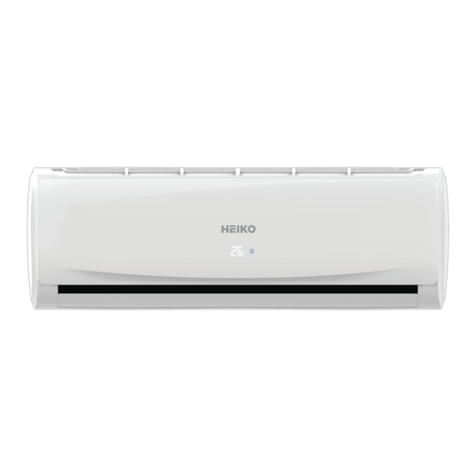
Heiko
Heiko JS026-B1 User manual
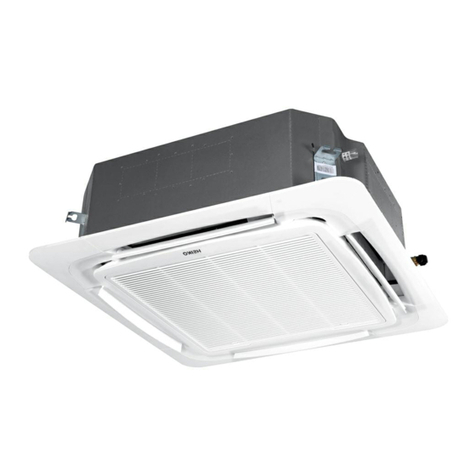
Heiko
Heiko CA100-A1 Installation and operating instructions
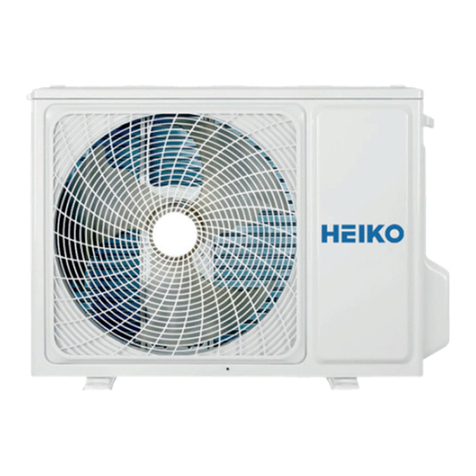
Heiko
Heiko H1U09TAAOUT User manual
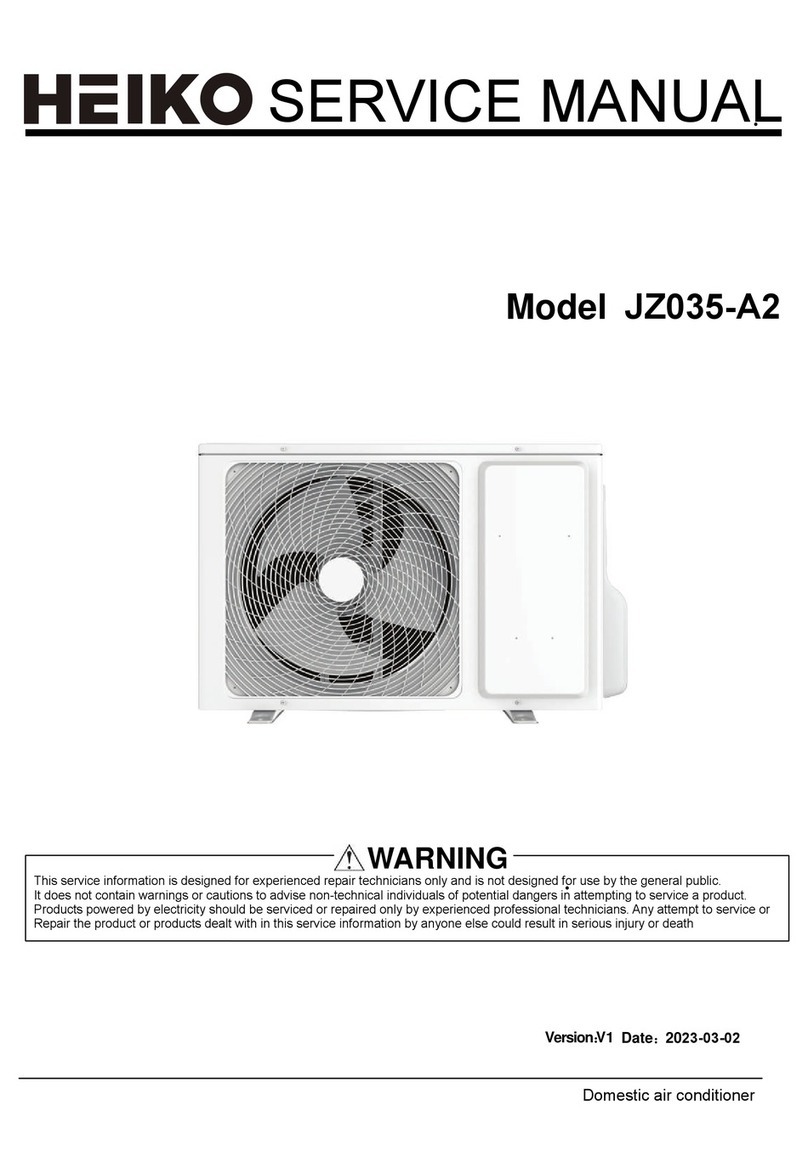
Heiko
Heiko JZ035-A2 User manual
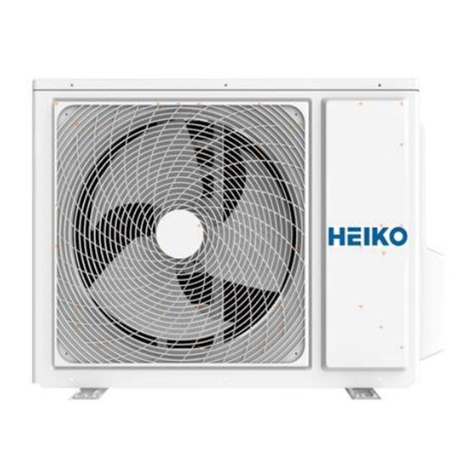
Heiko
Heiko T Series User manual
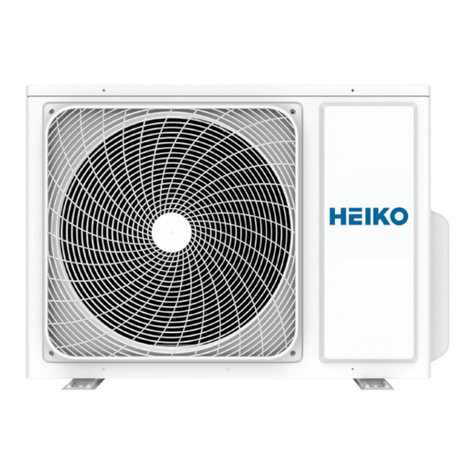
Heiko
Heiko JZ025-C1 User manual
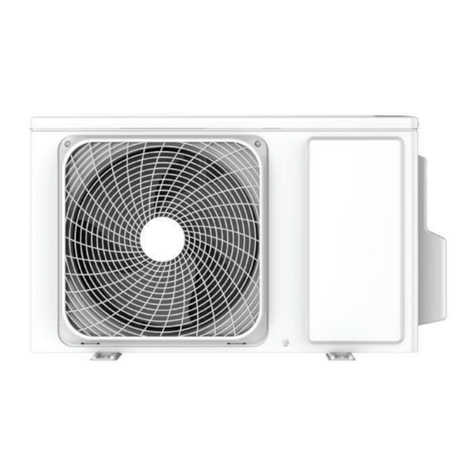
Heiko
Heiko JZ050-A2 User manual

Heiko
Heiko JS025-QW2 User manual
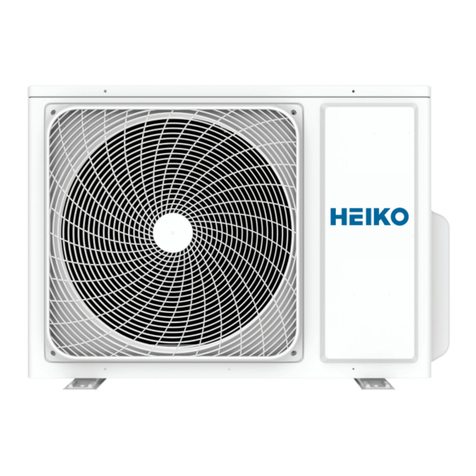
Heiko
Heiko JZ026-B1 User manual
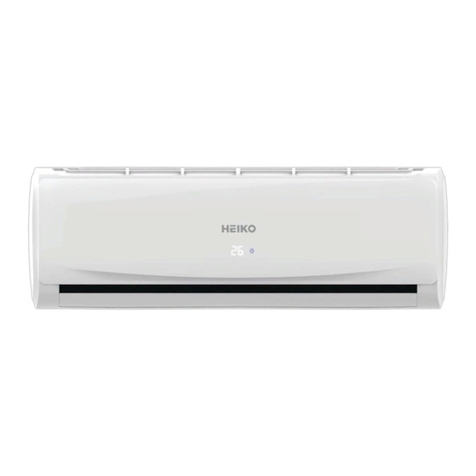
Heiko
Heiko JS035-C1 User manual
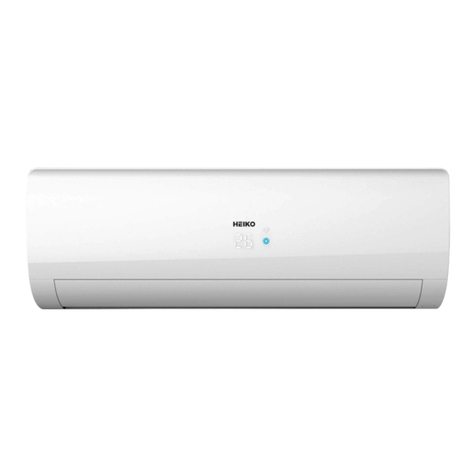
Heiko
Heiko JS068-C2 User manual
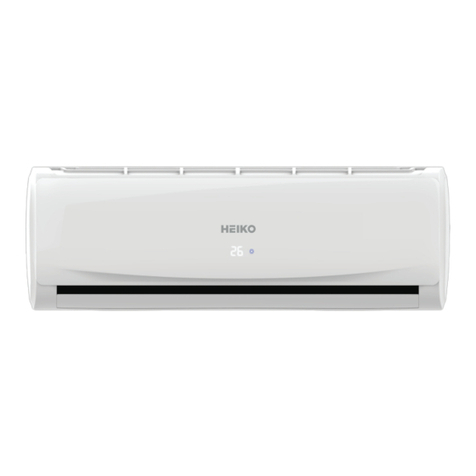
Heiko
Heiko JS026-D1 User manual
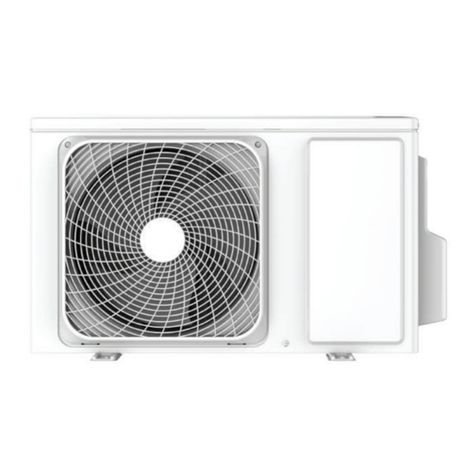
Heiko
Heiko JZ025-Q2 User manual
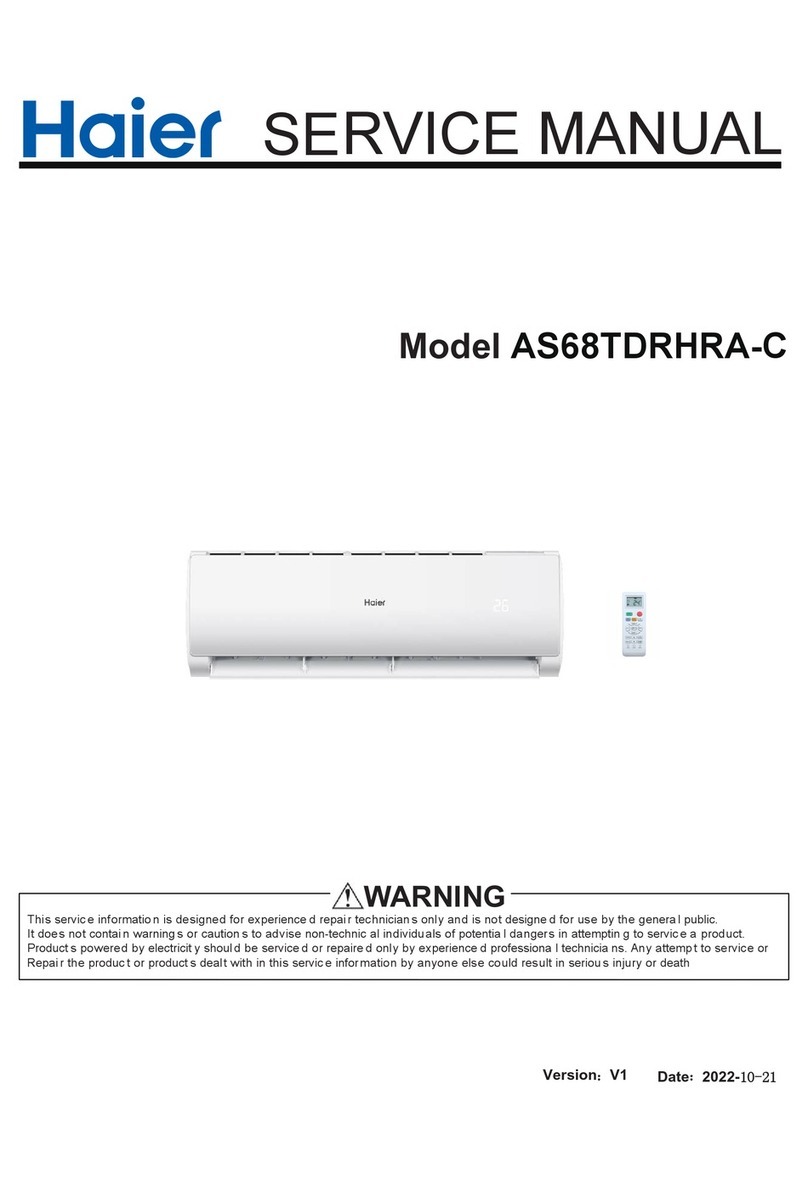
Heiko
Heiko AS68TDRHRA-C User manual
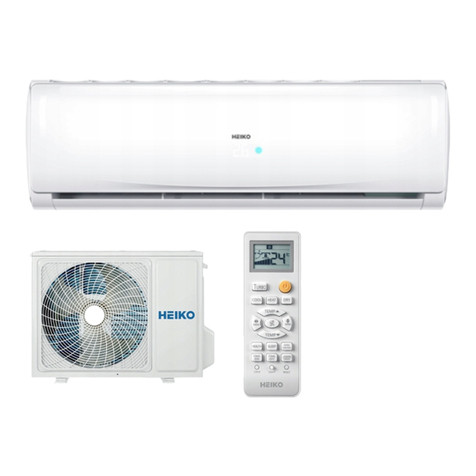
Heiko
Heiko JZ025-C2 User manual
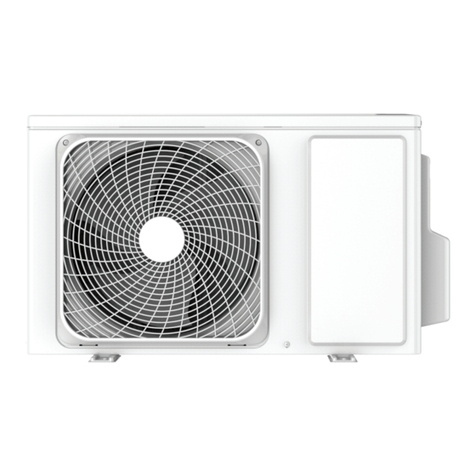
Heiko
Heiko JZ068-C2 User manual
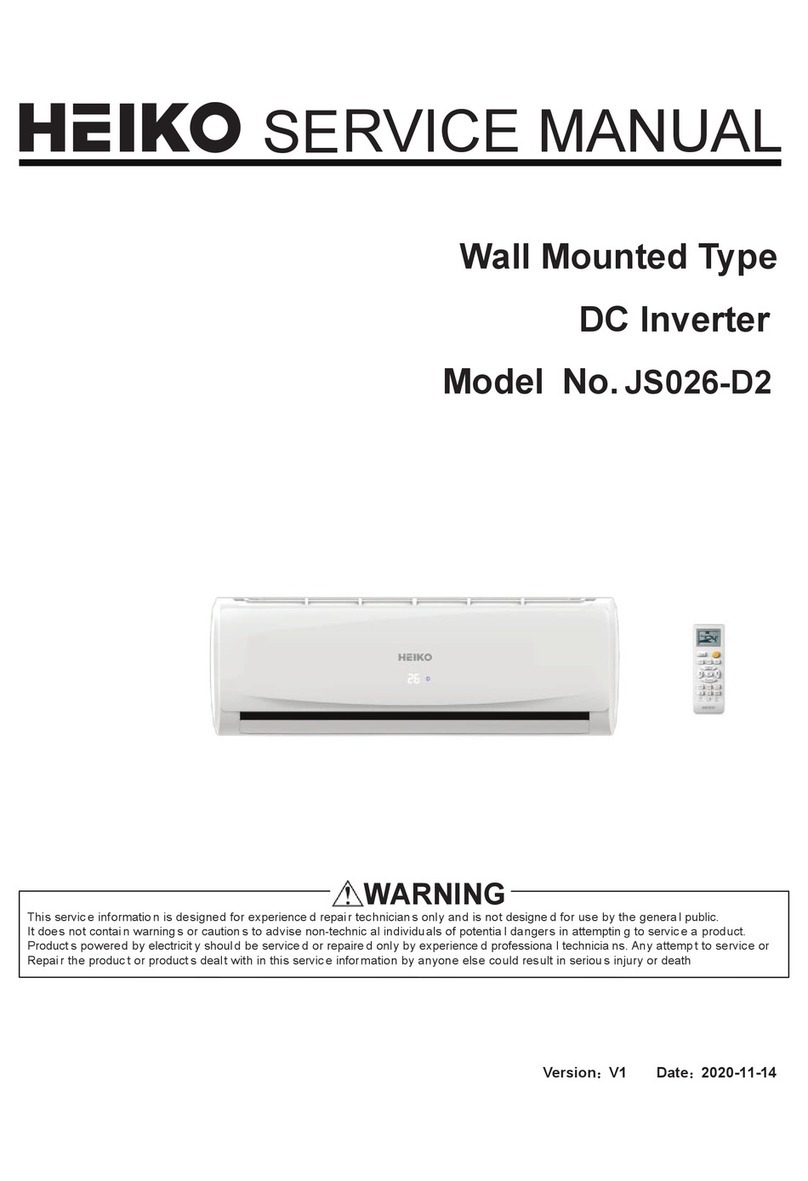
Heiko
Heiko JS026-D2 User manual
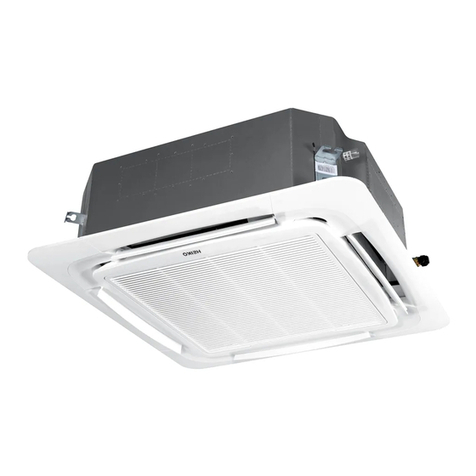
Heiko
Heiko CA035-A1 Installation and operating instructions

Heiko
Heiko M2T050-D2 User manual

Heiko
Heiko JS025-C2 User manual



